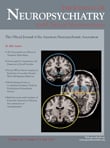Possible Neuroleptic Malignant Syndrome Associated With Paliperidone
SIR: Paliperidone, the major active metabolite of risperidone, is the newest of the second generation antipsychotics shown to be effective in treating schizophrenia. 1 A case of a patient developing a possible neuroleptic malignant syndrome (NMS) on adding paliperidone to tapering doses of quetiapine and trifluoperazine is described. Early diagnosis in this patient may have aborted a full-blown NMS in this patient.
Case Report
“Mrs. A,” a 63-year-old woman, was admitted to the psychiatric unit for exacerbation of chronic paranoid schizophrenia. Her current medications included quetiapine 1300 mg/day in divided doses, trifluoperazine 40 mg/day in divided doses, and clonazepam 1 mg at bed time. On admission, her urine toxicology screen, serum chemistries, and blood counts were within normal limits. She had a urinary tract infection, which was treated with nitrofurantoin and a repeat urine analysis after a week was unremarkable. In the past, Mrs. A had tried risperidone, aripiprazole, olanzapine, and clozapine, but there was insufficient information to ascertain the response to these medications. Mrs. A was initially continued on the same doses of quetiapine and trifluoperazine as her adherence with these medications had been questionable. However, with no improvement in the symptoms for 8 days after admission, paliperidone was started at 6 mg/day. At the same time quetiapine taper was begun and it was discontinued over the next 5 days, while paliperidone was increased to 9 mg/day. Two days after starting paliperidone, trifluoperazine was discontinued. Mrs. A’s delusions and hallucinations showed marginal improvement on paliperidone. However, 6 days after starting paliperidone, Mrs. A started complaining of increased stiffness. She had cogwheel rigidity and dysarthria on examination and was started on benztropine 1 mg po b.i.d. Her rigidity worsened over the next 2 days (eight days after paliperidone was started) despite being on benztropine. The patient was noticed to be more “confused” by the staff and also displayed diaphoresis. A repeat urine analysis, serum chemistries and blood counts were unremarkable. Her vitals suggested tachycardia (116 bpm), labile blood pressure (116/73–153/93 mmHg), and a mild increase in temperature (99.6°F). A preliminary diagnosis of NMS was entertained and a stat creatine phosphokinase (CPK) showed a modest elevation at 313 U/liter (normal 24–170 U/liter). Paliperidone was discontinued the same day and bromocriptine 25 mg po t.i.d and dantrolene 25 mg po daily were started. Her CPK level, however, continued to rise and peaked at 607 U/liter 3 days after paliperidone was discontinued. Over the 5 days following the discontinuation of paliperidone, the patient had complete resolution of rigidity, confusion and autonomic instability and her CPK level dropped to 268 U/liter and then to 74 U/liter over the next 2 days. The patient was not on any antipsychotics during this time and was only receiving clonazepam 1 mg at bed time and benztropine 1 mg b.i.d. The patient was seen by neurology who recommended discontinuation of bromocriptine and dantrolene at that time.
Eight days after stopping paliperidone, Mrs. A was restarted on quetiapine (gradually increased to 1200 mg/day) and, subsequently, trifluoperazine was also restarted and increased to the previous dose of 40 mg/day without any recurrence of symptoms of NMS. Benztropine was decreased to 0.5 mg b.i.d and the patient was discharged on this combination when her psychotic symptoms reached baseline.
Comment
This patient met the DSM-IV-TR criteria for NMS although hyperthermia was absent in this patient and other symptoms were mild in nature. This may be either due to the atypical presentation of NMS described with atypical antipsychotics or due to early recognition of the condition. 2 Paliperidone was implicated in this adverse effect because of the temporal relation between appearance of NMS symptoms and initiation of paliperidone and the failure of reemergence of NMS with the reintroduction of quetiapine and trifluoperazine. However, NMS has been described with neuroleptic discontinuation and the contribution of quetiapine and trifluoperazine in this presentation cannot be entirely excluded and the index neurotoxic reaction may have been a cumulative dose-related effect of the all the antipsychotics. 3 Premarketing data as per the package insert for paliperidone have described the occurrence of NMS with this drug and one patient developed possible NMS with it in a pivotal study. 1 , 4 However, a PubMed search through June 2007 using the key words ‘neuroleptic malignant syndrome’ and ‘paliperidone’ in English language literature did not yield any reports of NMS with paliperidone.
This case underscores the importance of early recognition of NMS and also alerts the clinicians to its association with paliperidone, which is expected as NMS has been reported with risperidone. 5 This case also highlights the shortcomings of the current diagnostic criteria for NMS, which are silent on the atypical presentation of this syndrome. This assumes significance as the cornerstones of diagnosing NMS such as extreme temperature elevation and muscle rigidity may be less frequent with the atypical antipsychotics. 3 , 5 Thus, with the widespread use of atypical antipsychotics, criteria geared more toward the early recognition of the atypical presentation of NMS are desirable. This is in line with the contention that a false positive diagnosis of NMS with unnecessary discontinuation of antipsychotics and exposure to antidote treatment may be less harmful than allowing for the progression of NMS, which may be fatal. 5
1 . Kramer M, Simpson G, Maciulis V, et al: Paliperidone extended-release tablets for prevention of symptom recurrence in patients with schizophrenia: a randomized, double-blind, placebo-controlled study. J Clin Psychopharmacol 2007; 27:6–14Google Scholar
2 . Duggal HS, Kithas J: Possible neuroleptic malignant syndrome with aripiprazole and fluoxetine (letter). Am J Psychiatry 2005; 162:397–398Google Scholar
3 . Caroff SN, Mann SC, Campbell EC: Atypical antipsychotics and neuroleptic malignant syndrome. Psychiatr Annals 2000; 30:314–321Google Scholar
4 . Janssen, L.P: Paliperidone drug information. Titusville NJ, Janssen, L.P., 2006Google Scholar
5 . Seitz DP: Diagnostic uncertainty in a case of neuroleptic malignant syndrome. Can J Emerg Med 2005; 7:266–272Google Scholar



